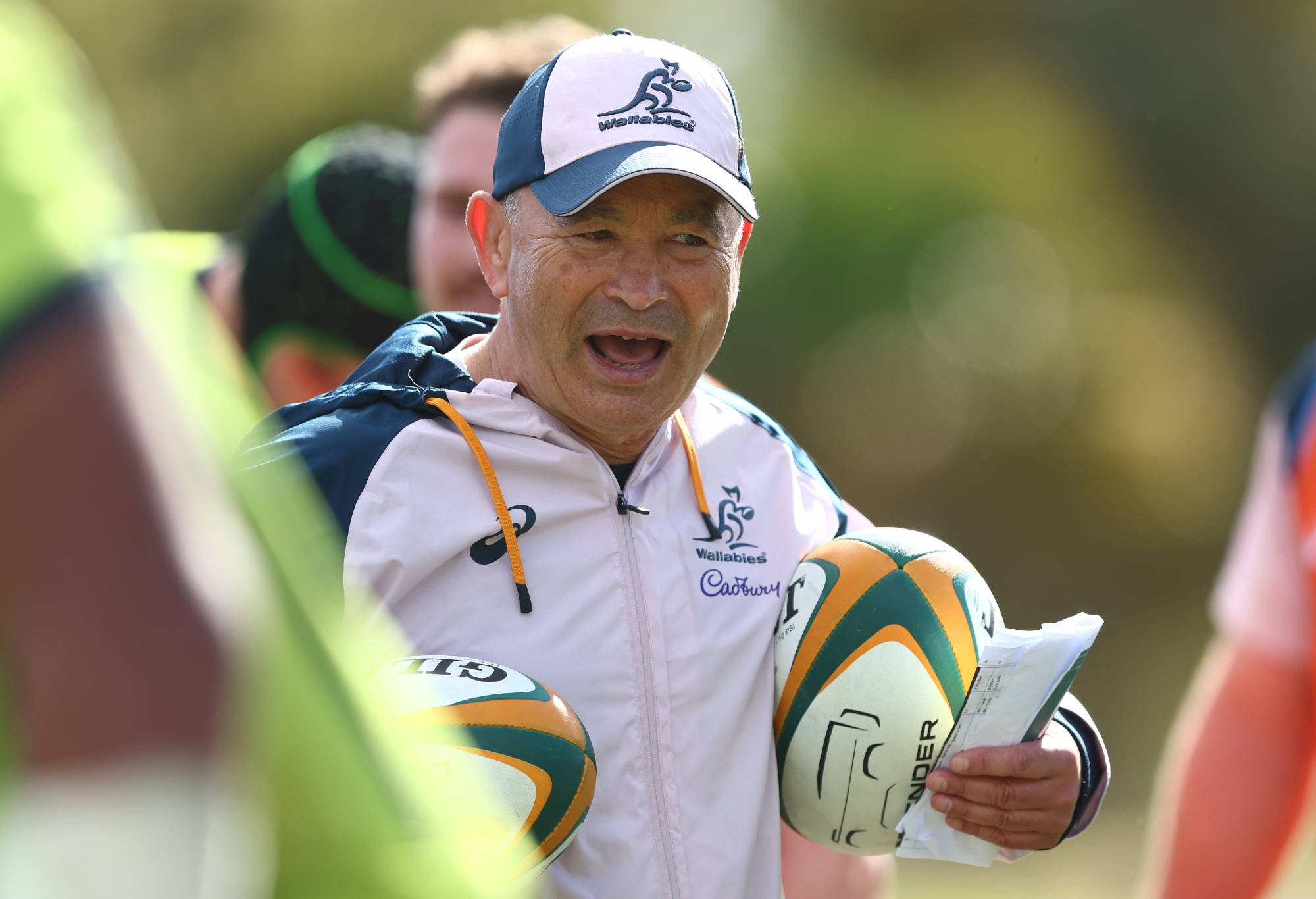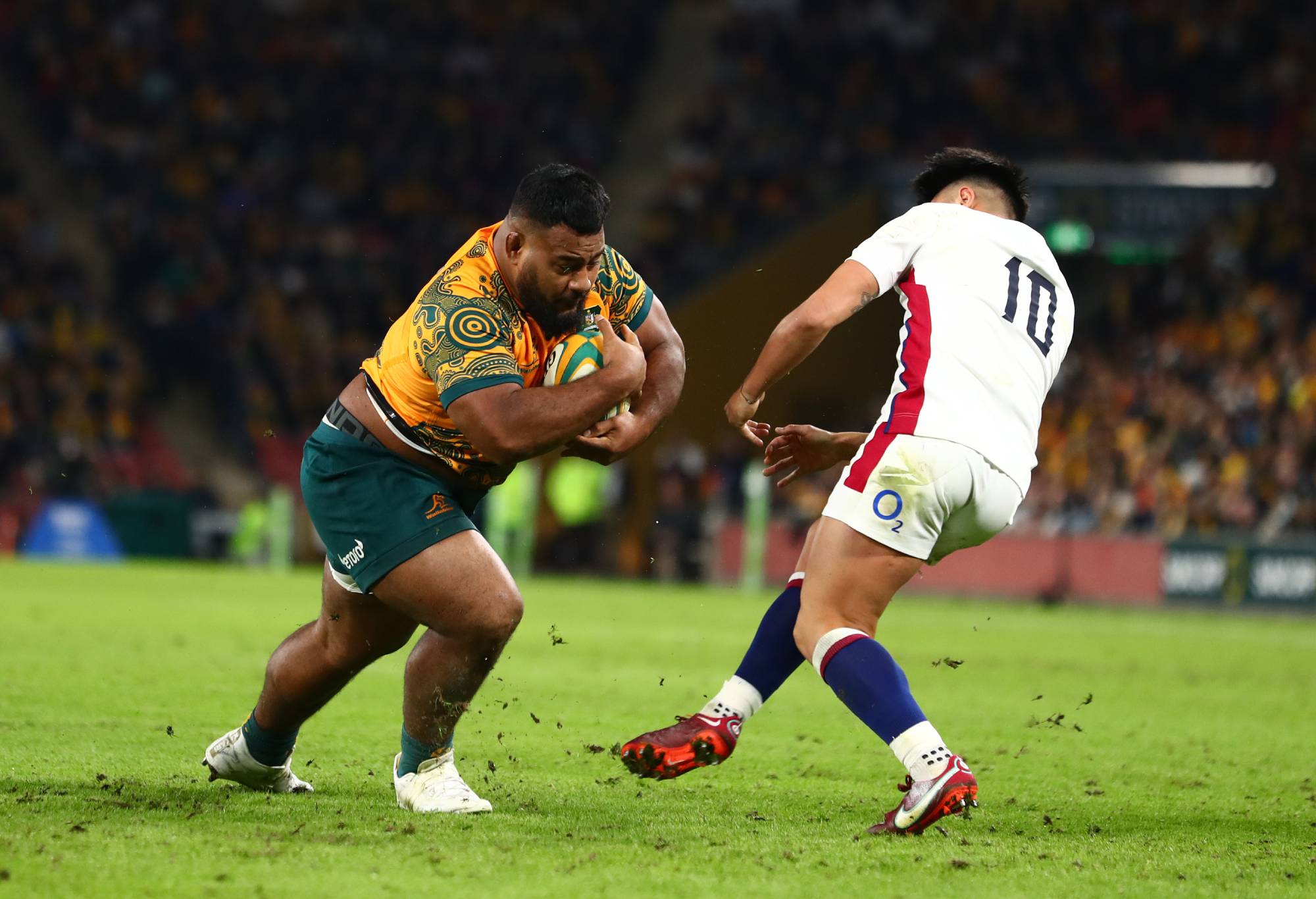Eddie Jones has finally picked his first Wallabies squad, and in a few days, he will reveal his first matchday XV which will face the Springboks on Sunday (1:05am). But how will Jones’ chosen play?
Attention must now turn to Jones’ gameplan and how his “smash and grab” job will actually be achieved.
There are little crumbs strewn throughout Jones’ media appearances which give us an insight into how the Wallabies could play.
“So we’ve got to be junkies for winning, not junkies for possession.”
“Possession rugby is dead. It’s dead for the moment and it’s probably going to be dead for a long period of time,” Jones told a rugby schoolboys event in March.

All year Eddie Jones has indicated the Wallabies won’t play the possession game. (Photo by Chris Hyde/Getty Images)
A winning attitude is the basis for all Jones does and he constantly reminds his squad of this.
“He (Jones) cares a lot. He is so unbelievably motivated, hey. Like every day he’s coming in and everything is about that winning mindset and getting better and it’s infectious,” Nic White said this week at Wallaby camp in Sanctuary Cove.
Jones wants the Wallabies to return to an Australian style; a tough, attacking style that innovates.
How Jones achieves this return to ‘Australian flair’ may just come from rugby’s cousin rugby league.
Jones loves rugby league and has a penchant for bringing league legends into his camps. His habit continued last week when he invited Immortal Andrew Johns into training camp.
“His (Johns’) ability to teach the nuances of first receiver play is second to none,” said Jones.
Jones is a mad sportsman in general, but his appreciation for league is due to the fact it’s fast, combative, simple and a game centred around power.
Below is how the 13-man code has influenced Jones’ Wallabies in 2023.
1. Possession
The first pillar of Jones’ “smash and grab” gameplan will be modelled of league’s 6-tackle count and what that restriction means in terms of playstyle.
“The game’s (rugby) about being fast now. You’ve got 75 per cent of tries being scored in three phases,” Jones said.
“So why would you keep the ball for 10 phases… That’s just stupid to even think like that anymore.”
If the stat of 75 per cent is correct, then it equates to half a league tackle count. Ergo efficient play and use of energy.
Everything Jones is coaching is about efficiency. You must make the most of the opportunities you create or are presented with, because in a World Cup they are few and far between. His squad is full of power athletes, they must strike hard, fast, and accurately.
2.Power
Jones wants his players to be powerful, and not being tied down in an arm-wrestle. In league impact is their first weapon on both attack and defence, then it turns to either slowing-down or speeding-up the play-the-ball to unsettle the opposition.
Rugby giant packs like France and South Africa along with well-drilled teams like Ireland and New Zealand will be looking for this arm-wrestle and to cause chaos at every breakdown.
It is easier to be powerful and precise over three phases than over 10, or until a kick becomes the only option.

Taniela Tupou represents the power game Eddie Jones wants. (Photo by Chris Hyde/Getty Images)
This means aggressive clean-outs on either side of the ball. For too long have Aussie clean-outs been ineffective and late.
Bodies must be in motion when carrying and once tackled, working hard on the ground to place the ball back.
Finally, tackling with the intent of interrupting the opposition’s flow, hit hard, stick, and make their fight to the ground as hard and slow as possible.
All this is to be done at pace, maximum impact to be done discriminately. The players must choose their moments and make sure their effort is not wasted. Those choices are dictated by where on the field the play finds itself.
3. Kicking
The third pillar is kicking. In league at the end of every set, they must kick, so doing it intelligently is key.
Jones wants the players’ smarts to match their brawn and kicking is a huge part of how Jones will attempt to exercise this genius.
“We’ve got to play smart, we’ve got to play to what the laws are now and we’ve got to play to our strengths, which is about being smart, being really fast and aggressive on the first couple of phases and then be able to kick constructively to get the ball back,” he said.
The team which kicks the best to retain possession currently is South Africa. It is a boring game to watch but it’s effective.
They play one or two phases and if no significant gain has been made, the ball is hoisted high from a box-kick for their electric wingers to chase. It gives them at least a 20m net gain every-time and it creates an opportunity to regather.

Kicking, particularly off No.9, will be a key feature under Eddie Jones. (Photo by Jono Searle/Getty Images)
This is the basic blueprint for Jones’ plan. The modification will come from where on the field he wants it employed and the variety of kicks.
If the Wallabies are between their 25m and the opposition 22m and no significant progress is made in two to four phases, then one of two things will happen.
1. A short kick (20m), either a grubber, chip or high-hoist, this will give his team a net gain as well as put his chasers on the front-foot to regather.
2. A long kick, to keep the ball in play or land a 50/22m. If the ball does not make touch for the 50/22m or the touchline was not its intended destination the choices for the opposition are as follows: enter a kicking duel or run it back with a hope to make-up the metres lost on the kick.
The benefit of both options is two-fold. The first is that it will generally keep the forwards moving forward. Basic perhaps, but the battle is truly won upfront as the adage goes. Jones knows this, unsarcastically having said that a ‘7-1 split’ bench is a possibility, so reserving your forwards’ energy levels is vital.

Eddie Jones’ “smash and grab” mission is about to get underway. Photo: Chris Hyde/Getty Images
The second is that it disorganises a team’s structure and hits a reset button on patterns. This is the window of ‘three phases’ Jones’ men will aim to target if they regather. With Jones’ wing stocks there is a high chance they will regather.
While the best system-based teams in the world like Ireland, France and perhaps South Africa will be good enough to weather this initially, others won’t be.
This type of kick strategy was most recently employed by the Queensland Reds in their two games against the Chiefs in Super Rugby Pacific. A powerful, staunch defence paired with a smart kicking game undid the Chiefs, who had not lost a game all season.
4. Discipline
The fourth pillar comes down to accuracy and harm minimisation. Discipline is the main focus here and it is something which plagued the Wallabies in 2022.
Discipline in league is vital, a call for “6-again” could spell doom for a defending opposition and so it should be treated by the Wallabies.
To remedy the discipline issues Jones has brought a referee to every training session. This is about much more than keeping his forwards onside at the ruck. This is about teaching his players when, how, and where to strike.
Conceding a penalty in the opposition’s 22m is a get out of jail free card for them, a penalty in their half is dangerous for your team, and conceding a penalty in your own half almost certainly guarantees at least three points against your team.
Therefore, there is really only 40m on the pitch where a team can afford a penalty. Only 22m on the pitch is where you would ever elect to concede a penalty if you had to choose.

The battle of the breakdown and staying on the right side of the referee will be vital in 2023. (Photo by Bradley Kanaris – The RFU/The RFU Collection via Getty Images)
So, Jones inviting a ref to his trainings is as much about keeping his players onside and legal at ruck time, as it is about educating his players about how far they should push the opposition in their own 40m. That’s the time to go full tilt into the opposition’s ruck: pilfer, counter-ruck, put the big hit on and chase your feet.
Jones is detail driven and his players already have a crystal-clear vision of how they will play in the Pretoria next week. The coming week is about just sharpening the axe, a process that will be done throughout the Rugby Championship but make no mistake, Jones wants to win everything; Bledisloe, Championships, and, most of all, the Webb Ellis in France.
The toughness and speed of league is what intrigues Jones, and it is those elements along with executing the simple things whilst being direct that he can add to the Wallabies DNA.
Jones believes his simple and clear gameplan can get the Wallabies winning matches.
“You just have a look at the Australian backline that we could pick, we’ve probably got the most powerful backline in the world,” he said.
He clearly believes he has the backs to be able to do it all in 2023. Whoever he picks for the Highveld on Sunday, you can be sure they have the gameplan burned into their brain.

































































































